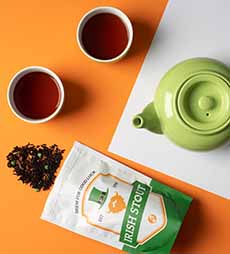Adagio Irish Stout Tea, A Limited Edition For St. Patrick’s Day
|
|
The Irish now drink more tea per capita than any other nation in the world—between six and seven cups a day, says the Irish Times. That’s an estimated seven pounds of dry leaves tea leaves each year. You may consider waking up on St. Patrick’s Day to a cup of Irish Breakfast tea. Or, celebrate the day with something even more special: Adagio’s limited-edition Irish Stout tea. Irish Stout tea isn’t particularly a breakfast tea* like the well-known Irish breakfast. Rather, it can be drunk at any time of the day, hot or iced. And the chocolate and mint notes make it a contender for hot or cold dessert coffee, with a crown of whipped cream. We found it to have subtle notes of chocolate and mint and it was no surprise when we looked at the ingredients: Assam Melody, Ceylon Sonata, Chicory, Cocoa Nibs, Natural Chocolate Flavor, Natural Creme Flavor, and sprinkles (the little shamrocks in the photo). If you don’t have an infuser spoon or infuser basket for loose tea leaves, you can use a spice ball. Or, purchase paper tea filter bags to brew the loose leaves. Whether loose tea or a teabag, here’s how to brew your cup of tea. > THE HISTORY OF TEA > THE DIFFERENT TYPES OF TEA |
|
|
________________ *Irish breakfast tea is a hearty blend of black teas, most often a combination of strong, malty Assam tea and the softer Ceylon tea (with more weight to Assam). All breakfast teas are commonly served with milk, but may also be consumed black, or with sugar or honey. Breakfast teas, always hearty black tea blends, are intended as part of a hearty morning meal. – Irish breakfast tea has a robust taste, and is reddish in color from the Assam, which also contributes higher caffeine levels. – English breakfast tea, full-bodied and rich, was originally a China black tea but now often includes a strong Ceylon element. It can also include teas from Assam, Africa, and/or Indonesia. –Scottish breakfast tea is typically the strongest of the three. It may include teas from China, Assam, Ceylon, Africa, and/or Indonesia. It’s important to note that there never has been a standard formula for any of these blends. Each tea seller makes its own blend [source]. |
||





